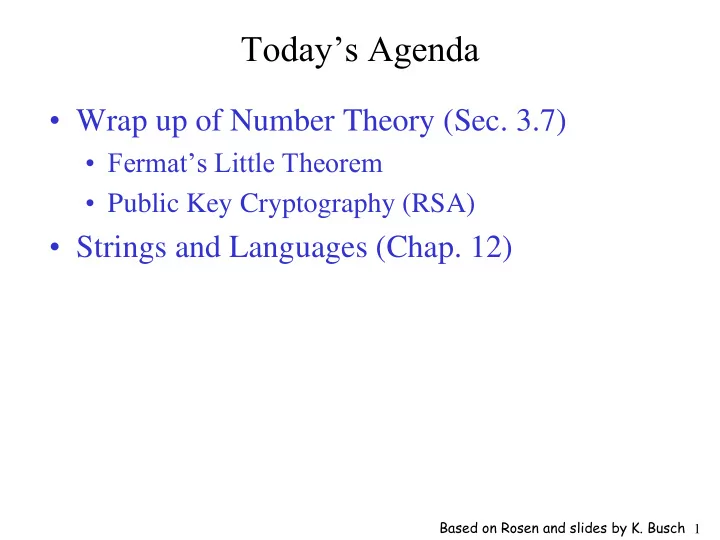

Today’s Agenda • Wrap up of Number Theory (Sec. 3.7) • Fermat’s Little Theorem • Public Key Cryptography (RSA) • Strings and Languages (Chap. 12) Based on Rosen and slides by K. Busch 1
Fermat’s little theorem: For any prime and p integer not divisible by p a ( ): gcd( , ) 1 a p a a p 1 1 (mod p ) Pierre de Fermat (1601-1665) Example: p 5 a 2 2 4 16 1 (mod 5 ) (We will use FLT in the RSA cryptosystem) 2
Public Key Cryptography (RSA cryptosystem) “MEET YOU IN THE PARK” encryption decryption e mod d mod 1 ( ) ( ) f x x n f y y n “9383772909383637467” are public keys n p q n , e are private keys for p , q Large primes finding d for any e (with the condition that ) gcd( e , ( p 1 )( q 1 )) 1 3
Key Idea: Everyone knows n (= pq) and e , but to find d to decrypt, need to know what p and q are. Practically impossible to factor n into p and q if p and q are chosen to be primes of 200 digits or more. 4
Encryption example: q 59 e 13 43 p n p q 2537 gcd( e , ( p 1 )( q 1 )) gcd( 13 , 42 58 ) 1 Message to encrypt: “STOP” Translate to equivalent numbers “18 19 14 15” Group into blocks of two numbers “1819 1415” 5
Apply encryption function “1819 1415” to each block e f ( x ) x mod n Encrypted 13 x mod 2537 message: “2081 2182” Use fast modular exponentiation algorithm: 13 ( 1819 ) 1819 mod 2537 2081 f 13 ( 1415 ) 1415 mod 2537 2182 f 6
Message decryption :an original block of the message M “1819 1415” encrypt “2081 2182” :respective encrypted block C e C M (mod n ) We want to recover by knowing M C , p , q , e 7
Let = inverse of modulo ( p 1 )( q 1 ) d e de 1 (mod( p 1 )( q 1 )) by definition of congruent de 1 k ( p 1 )( q 1 ) Does inverse d always exist? Inverse exists because gcd( e , ( p 1 )( q 1 )) 1 gcd( e , ( p 1 )( q 1 )) 1 se t ( p 1 )( q 1 ) i.e., 1 mod( 1 )( 1 ) se p q d s 8
Encryption e C M (mod n ) d Decryption d e (mod n ) C M de 1 k ( p 1 )( q 1 ) 1 ( 1 )( 1 ) d de k p q C M M (mod n ) 9
In real-world case, gcd( M , p ) 1 (because is a large prime and is small) p M Remember me? gcd( M , p ) 1 By Fermat’s little theorem 1 M p 1 (mod p ) 10
1 M p 1 (mod p ) k ( q 1 ) p 1 k ( q 1 ) 1 1 (mod ) M p M M (mod p ) Multiply under mod k ( q 1 ) p 1 1 (mod ) M M M p 1 ( 1 )( 1 ) k p q M M (mod p ) 11
We showed: 1 k ( p 1 )( q 1 ) (mod ) M M p By symmetry (by replacing with ): p q 1 k ( p 1 )( q 1 ) (mod ) M M q By Exercise 23 (Sec. 3.7): 1 k ( p 1 )( q 1 ) (mod ) (mod ) M M pq M n 12
We showed: 1 ( 1 )( 1 ) d k p q C M (mod n ) C d M (mod n ) 1 k ( p 1 )( q 1 ) (mod ) M M n In other words, the original message: d mod M C n 13
Decryption example: q 59 e 13 43 p n p q 2537 gcd( e , ( p 1 )( q 1 )) gcd( 13 , 42 58 ) 1 42 Compute = inverse of modulo = e d 58 937 “2081 2182” d mod M C n 2081 937 2182 937 mod 2537 1819 mod 2537 1415 “1819 1415” “18 19 14 15” = “STOP” 14
Recommend
More recommend